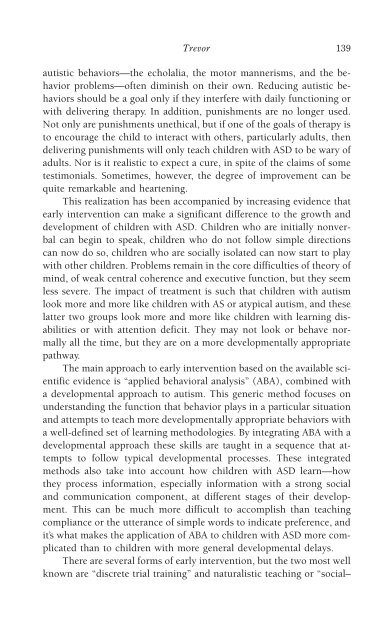978-1572305441
autism
autism
You also want an ePaper? Increase the reach of your titles
YUMPU automatically turns print PDFs into web optimized ePapers that Google loves.
Trevor 139<br />
autistic behaviors—the echolalia, the motor mannerisms, and the behavior<br />
problems—often diminish on their own. Reducing autistic behaviors<br />
should be a goal only if they interfere with daily functioning or<br />
with delivering therapy. In addition, punishments are no longer used.<br />
Not only are punishments unethical, but if one of the goals of therapy is<br />
to encourage the child to interact with others, particularly adults, then<br />
delivering punishments will only teach children with ASD to be wary of<br />
adults. Nor is it realistic to expect a cure, in spite of the claims of some<br />
testimonials. Sometimes, however, the degree of improvement can be<br />
quite remarkable and heartening.<br />
This realization has been accompanied by increasing evidence that<br />
early intervention can make a significant difference to the growth and<br />
development of children with ASD. Children who are initially nonverbal<br />
can begin to speak, children who do not follow simple directions<br />
can now do so, children who are socially isolated can now start to play<br />
with other children. Problems remain in the core difficulties of theory of<br />
mind, of weak central coherence and executive function, but they seem<br />
less severe. The impact of treatment is such that children with autism<br />
look more and more like children with AS or atypical autism, and these<br />
latter two groups look more and more like children with learning disabilities<br />
or with attention deficit. They may not look or behave normally<br />
all the time, but they are on a more developmentally appropriate<br />
pathway.<br />
The main approach to early intervention based on the available scientific<br />
evidence is “applied behavioral analysis” (ABA), combined with<br />
a developmental approach to autism. This generic method focuses on<br />
understanding the function that behavior plays in a particular situation<br />
and attempts to teach more developmentally appropriate behaviors with<br />
a well-defined set of learning methodologies. By integrating ABA with a<br />
developmental approach these skills are taught in a sequence that attempts<br />
to follow typical developmental processes. These integrated<br />
methods also take into account how children with ASD learn—how<br />
they process information, especially information with a strong social<br />
and communication component, at different stages of their development.<br />
This can be much more difficult to accomplish than teaching<br />
compliance or the utterance of simple words to indicate preference, and<br />
it’s what makes the application of ABA to children with ASD more complicated<br />
than to children with more general developmental delays.<br />
There are several forms of early intervention, but the two most well<br />
known are “discrete trial training” and naturalistic teaching or “social–



